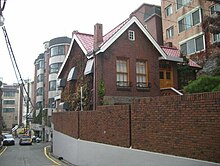Hong Nan-pa
| Hong Nan-pa | |
| Hangul | 홍난파 |
|---|---|
| Hanja | |
| Revised Romanization | Hong Nan-pa |
| McCune–Reischauer | Hong Nanp'a |
| Birth name | |
| Hangul | 홍영후 |
| Hanja | |
| Revised Romanization | Hong Yeong-hu |
| McCune–Reischauer | Hong Yonghu |
Hong Nan-pa (April 10, 1897 – August 30, 1941) was a Korean composer, violinist, conductor, music critic and educator.[1] He is best known as the composer of Bongseonhwa (봉선화, literally Garden Balsam) written in 1919.[2] It is generally considered as the first true Korean original song[3] composed in Western style.[4][5][6] It was widely sung during the period. Hong also contributed to developing Korean culture during the period with his diverse cultural activities.[2][7][8]
Biography
Hong Nan-pa was born at Hwalcho Village of Namyang Township in present Hwangseong County, Gyeonggi on April 10, 1897.[9] He was the second son to his father, Hong Sun (홍순) of the native Hong Clan to Namyoung (南陽) and his mother from Lee Clan of Jeonju, Jeolla. He had one brother and two sisters. Nan-pa is his ho, or pen name, but his given name is Hong Yeong-hu. His family moved to Seoul when he was still a young child. As he lived near the Ewha Academy (이화학당) located in the neighborhood of Jeong-dong,[10] he attended Jeongdong Methodist Church and got access to hymn, a Western music.[2][8][11]
He learned basic Confucian studies at a local seodang (a kind of elementary school) and entered a middle school in 1910 which was affiliated with the Hwangseong Young Men's Christian Association (황성기독교청년회, Korean YMCA). Since then, he had a violin and received music lessons. At the age of fifteen, Hong was admitted to the Western music department of Korean Court Music Study Institute (조선정악전습소 Joseon Jeongak Jeonseupso) that was the only music school in Korea at that time. He studied vocal music and violin from Kim In-sik (김인식). After the graduation, he was hired as an assistant teacher at the school.[2]
In 1918, he went to Japan to enter Tokyo Music School in Ueno but returned to Korea to participate in the March 1st Movement as temporarily absent from the school. One year after the movement, he went back to Japan. However, Hong was rejected to continue his study at the school because of his involvement in the independent movement, so that he came back to Korea in despair. During his stay in Japan, he published the first Korean music magazine titled "Samgwang" (삼광, literally "Three Light"). After his return, he worked as a news report for Maeil Sinbunsa, and even attended Severance Medical School which became later the medical department of Yonsei University.[8]
In April, 1920, Hong included the score of Aesu (애수, literally "sorrow"), a violin piece on the end pages of his short novel "Cheonyeohon" (lit. "a maiden's soul). He asked Kim Hyeong-jun for lyric for the tune whose song is "Bongseonhwa" (봉선화). In 1922, Hong made efforts to promote music while he participated in Yeongakhoe (연악회, Music Research Society) established by Gyeongsang Akuhoe (경상악우회 Gyeongsang Music Friend Society)'s lead. In 1925, he had the first solo violin recital as a Korean and published "Eumakgye" (음악계, Music World), the first music magazine published in Korea. Hong also wrote Eumakmanpil (음악만필, Music Essay) in Changjo. In 1926, as Hong entered Kunitachi College of Music as a transfer student, he was accepted to play first violin at Tokyo Symphony Orchestra (current NHK Symphony Orchestra). After graduation in 1929, he returned to Korea and published the first volume of "100 pieces of Joseon Children's song" (조선동요 100곡집) through Yeongakhoe.[8]

Media
See also
Footnotes
- ^ http://www.baks.org.uk/Book%20Reviews%202002-5.html
- ^ a b c d 홍난파 (洪蘭坡) (in Korean). Empas / EncyKorea. Retrieved 2008-09-30.
- ^ Howard, Perspectives on Korean Music P. 104
- ^ Robert Koehler (2006-03-09). "Korean Traditional Music Goes Fusion". Monthly Magazine SEOUL.
- ^ http://www.asianinfo.org/asianinfo/korea/perform/modern_music.htm
- ^ http://keemanchang.com/keeman_diction4.html
- ^ 홍난파 (洪蘭坡) (in Korean). Doosan Encyclopedia. Retrieved 2008-09-30.
- ^ a b c d 홍난파 (洪蘭坡) (in Korean). Empas / Britannica. Retrieved 2008-09-30.
- ^ 최은주 (2007-06-29). 음악가 홍난파의 생가를 찾아서 (in Korean). News Hankuk. Retrieved 2008-09-30.
- ^ Ewha Academy (이화학당) is the predecessor of Ewha Women's University and Ewha Girls' High school
- ^ 홍난파 (in Korean). Suwon City Government. Retrieved 2008-09-30.
References
- Keith Howard (2006). Perspectives on Korean Music: Intangible Cultural Properties as Icons of Identity. Ashgate Publishing, Ltd. ISBN 0-7546-5729-9.

